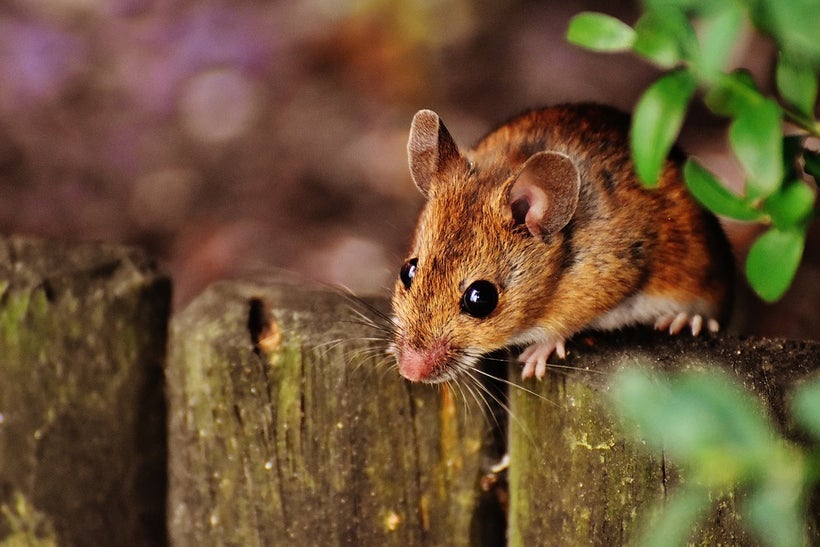The cooler months of fall have now arrived. But if you’re already nostalgic about those early October animal blessings that took place in honor of St. Francis (the patron saint of animals and ecology) take heart! The good news is that you need not wait until next year’s events to extend the blessing to creatures all around us. Here are a few great ways for communities of faith and families to put compassion into action starting today. While animals will benefit, most carry bonus incentives for people, too.
#1 Beatutify by building bird-friendly

The Problem
Existing places of worship are constantly undergoing remodeling projects, and new churches are often being built. But when stained glass windows are replaced with clear glass, the outcomes can be devastating for birds. With fall migration well underway, the risk of glass collision is all too real. And the problem isn’t insignificant. According to the American Bird Conservancy, up to a billion birds of all categories from hummingbirds to falcons lose their lives to such collisions. They occur because birds cannot tell the difference between reflections and reality, according to Dr. Christine Sheppard, director of the American Bird Conservancy’s Glass Collision Program.
The Solution
Fortunately, there are quick and affordable ways to protect birds from your church’s glass windows right away. Through its Bird Smart Glass Program, Sheppard’s organization offers tested solutions for everyone from architects and builders to individual homeowners. The organization also provides a more in-depth bird-friendly building design guide on how to avoid collisions. It includes a section for building owners to assess collision potential such as location, weather and light pollution. Given that fall and winter are often the prime times for planning spring and summer construction projects, it could be a great resource to keep on hand!
Bird-friendly design options can save energy and money, all while benefitting the environment and enhancing beauty. One particularly awe-inspiring and innovative design (pictured above) can be found at The Cathedral of the Holy Family in Saskatoon, Canada. Named, “Lux Gloria” (“The Light of Glory”) and designed by Ontario artist Sarah Hall, it is the first cathedral in the world whose solar stained glass windows generate energy from sunlight. The photovoltaic system, made with bird-friendly patterns, is expected to provide approximately 2,500 kilowatt-hours of energy annually. Meanwhile, the Cathedral will receive a rebate on energy costs through the utility grid.
#2 Welcome the stranger by welcoming his best friend

The Problem
It is estimated that in some places in the United States, nearly one in four homeless men and women have pets. Yet, animals belonging to the homeless are often the primary source of comfort, security, and consistency in an otherwise cold, unsettling and unpredictable world. Because shelters often do not accept pets, owners find themselves in a tough spot as frigid temperatures arrive. Rather than giving up their best friend, many have chosen to remain outdoors.
The Solution
In the nation’s largest cities, faith-based organizations are reported to provide more than half of all emergency shelter beds. In at least one city, this number rises to as many as 90 percent of beds. A number of options exist for reducing access barriers to those with animals. Compass at First Presbyterian, a partnership between Compass Housing Alliance and Seattle First Presbyterian Church, hopes to serve as a model for addressing three of the top barriers that prevent people from seeking shelter: pets, possessions and partners. According to, Robert Taylor, program coordinator, a grant from the City of Seattle incorporates provisions for this 24/7 shelter to welcome people and their pets. Taylor says the program relies on local animal societies for items like crates, food, leashes and other supplies. The shelter has basic rules in place to help ensure the safety and well-being of everyone present.
Not quite ready to open up a space for pets at your congregation? Other faith-based groups have found creative ways to partner with local humane societies. Michele Sanders Brinson of Nashville Rescue Mission, for example, described how her organization has served as a site for Nashville Humane Society’s mobile “Rover” unit to provide care for pets while their owners take refuge indoors. She recognized a problem after some refused to seek shelter indoors in dangerous temperatures for fear of leaving pets behind.
“Finding unique and interesting ways to reach those in need who might otherwise suffer or struggle, like partnering with Rover, is just one more way we try to remove barriers for those walking through our doors in need of help and hope,” Brinson said.
Don’t operate a shelter, but engage in homeless outreach at your congregation? Consider developing resources such as information cards with any local resources available to assist homeless men and women with pets. Pets of the Homeless, a national organization dedicated to assisting homeless people and their pets, provides a listing of many of these resources on the local, state and national levels. This year, Brinson’s organization will be positioned to refer those in need with pets to Rover’s new location, a shelter more accessible to those seeking short-term accommodation on some of the coldest days of the year.
She noted, “While I'm disappointed that Rover won't be onsite with us this winter, I am delighted they will continue to make their mobile unit available to those homeless men and women who may seek shelter with the city's temporary winter shelter. I know for many of those struggling with homelessness, there are lots of different factors that contribute to those who refuse shelter and choose to live on the streets. I would hope that a temporary shelter run by the city might be less intimidating perhaps than coming to our facility which houses so many people.”
Coming to the aid of homeless people with pets is often an overlooked opportunity for ministry for serving those in great need. According to Taylor, partnering with First Presbyterian made sense at a time when congregations are declining in membership.
Taylor explained, “This is an opportunity for Compass and the church to ask how can the church stay relevant and impactful in the community and how can Compass stay dynamic and address specific restraints keeping people from accessing these resources?”
Brinson also noted that the local response to her organization’s ministry for people with pets, which aligned with her organization’s values, was “extremely positive.”
She added, “Nashville Rescue Mission's doors are open to those in need. We do not discriminate. God calls us to love each and every person. “
If finances pose an obstacle to offering assistance, resources may be available. PetSmart Charities, for example, helps support Family Promise Affiliates (including affiliate congregations) to provide a wide range of boarding and veterinary services for pets of families experiencing homelessness. In a newly launched Pets with a Promise program, these resources will now be accessible nationwide. Other organizations like the Banfield Foundation have also assisted shelters in keeping people and pets facing homelessness together by providing services such as veterinary and kenneling support.
#3 Vamp up veggies while nourishing a ministry

A whopping 10 billion animals are slaughtered for food each year on average, with over 99% of farm animals raised in factory farms. Not only have horrific and routine incidents of animal cruelty been documented, workers are often subjected to extremely hazardous conditions. At the same time, meat consumption has been named as a key contributor to greenhouse gas emissions, chronic disease and even habitat and species destruction. Ironically, because church gatherings can produce large amounts of leftover food that can quickly spoil, animal-based foods may be the first to be tossed in the trash. This reality is doubly unfortunate given that these foods have a greater negative impact on the environment than vegetable food waste.
The Solution
Interestingly, this problem, which arguably carries the largest negative impact to the well-being of others and the planet, has a relatively simple solution: replace animal-based foods with healthy plant-based options. These options can also be wonderful enough to satisfy anyone’s taste buds and can fit within a range of budgets. And vegan recipe ideas specifically geared toward church gatherings like these abound.
Thinking about encouraging your faith-based institution to make a more formal commitment to humane eating? Consider adopting an institutional food policy with the help of organizations like CreatureKind.
According to CreatureKind co-director Sarah Withrow King, “Many people realize that making individual changes to their diets will have a positive impact on their own health, the health of the planet, and the welfare of animals raised and killed for food. We are working with nonprofits, universities, conferences, and more to help these communities reduce their overall consumption of animal products, move to higher welfare sources for the remaining animal products, and engage with their communities about the changes. “
Fall is the perfect time to prepare for compassionate Thanksgiving, Christmas and Lenten seasons. And plant-based eating may be natural complement to numerous other ministries. Have a coffee and donuts hospitality ministry? Consider bakeries that offer vegan donut varieties or make your own and offer coffee that is bird-friendly. And if your ministry has a film theme, consider watching or discussing the film Eating Mercifully, offered for free by the Faith Outreach program of The Humane Society of the United States. Have a health-based ministry? Consider trying the Daniel Diet as a community. Have an eco or other social justice ministry? Consider the connections between environmental problems and animal based foods.
Here’s another added perk: plant-based recipes are naturally free of some of the most common allergens such as eggs and dairy and tend to also be more heart-healthy. Nothing says hospitality better than welcoming more people to the table!
#4 Leave the leaves while accommodating abundance

The Problem
Raking and discarding fallen leaves destroys the habitat of several species of wildlife as well as beneficial insects and nutrients for trees. Discarded leaves often also make their way to the landfill where they contribute to greenhouse gasses.
The Solution
Leave the leaves, according to Nancy Lawson, author of The Humane Gardener: Nurturing a Backyard Habitat for Wildlife.
“We humans too often see leaves as debris, but for so many animals, life begins in the decay. Queen bumblebees who overwinter under blankets of leaves and loose soil will emerge in spring to start whole new colonies. Butterfly pupae await spring among the fallen leaves. Birds forage on seeds, berries and insects that collect in this rich ground layer. In spring, mother rabbits create perfectly camouflaged nests there, too. You can help all these animals by leaving the leaves under trees and shrubs,” said Lawson.
Not only can leaving the leaves create a rich environment for animals and save lawn maintenance effort, but if your church has a garden, the leftover leaves can have another useful purpose.
“When leaves have gathered on driveways and other hardscaping, collect them for use in your garden beds, where they can act as natural mulch, provide food and shelter for wildlife, and enrich the soil as the decompose,” Lawson suggested.
#5 Save a mouse while saving money

The Problem
Particularly as temperatures fall, wild mice and other animals find their way indoors for warmth and shelter. Unfortunately, inhumane glue boards and poisons and other methods are used to address the issue. Not only are these particular methods extremely cruel and unnecessary, they often have unexpected consequences like catching or poisoning other small mammals such as songbirds, chipmunks, bats, and more. Additionally, extermination-only methods are ineffective for preventing unwanted intrusions. And this lack of effectiveness comes at a cost. In many cases, yearly pest control contracts can rival or exceed the cost of running various ministries or even the cost of hiring part-time staff!
The Solution
St. Francis was known to care even for the smallest of creatures, and there are many options to continue this tradition today. A number of humane, long-term, inexpensive exclusion methods exist to prevent entry of unwanted wildlife. For mice, specifically, The Humane Society of The United States has provided numerous suggestions to protect entry points.
John Griffin, director of the organization’s Urban Wildlife program, recommends asking some basic questions to reduce the numbers of animals who have access to the building. According to Griffin, the work begins with developing an understanding of how animals get in and where, at what time in the year they have their young and which vulnerable openings in the building exterior exist. Because it doesn’t take much food to sustain wild visitors, an emphasis on proper storage is also crucial.
Emphasizing that effective wildlife exclusion and humane approaches go hand in hand, Griffin noted that an ounce of prevention is key.
“If you’re just going to kill animals, it’s something you’re going to continue to do. [Non-lethal reduction and mitigation alternatives] don’t just solve the immediate problem, but solve the problem for the long-term,” Griffin remarked.
Looking for professional and personalized assistance with humane wildlife solutions in your area? Check out the Humane Wildlife Control Association, a developing group that uses best practices in humane exclusion methods. If an operator is not yet available in your area, the Humane Society offers tips for vetting a local wildlife control company as well as handy DIY steps that can be done by individuals.
Choosing humane one-time exclusion options may amount to thousands of dollars saved over time, not to mention the substantial energy savings that could result from sealing up all potential entryways. Effective exclusion can go a long way!
